Chestnut fencing in an orchard
How do I look?
Most of the fence is up.

Well, I am ten metres short of being a garden designer and a slave to the aesthetics of a rural orchard. But that will have to wait.
It is wonky in parts. Secured with wire rather than hammered in nails. But it might, might deter a grazing beast.
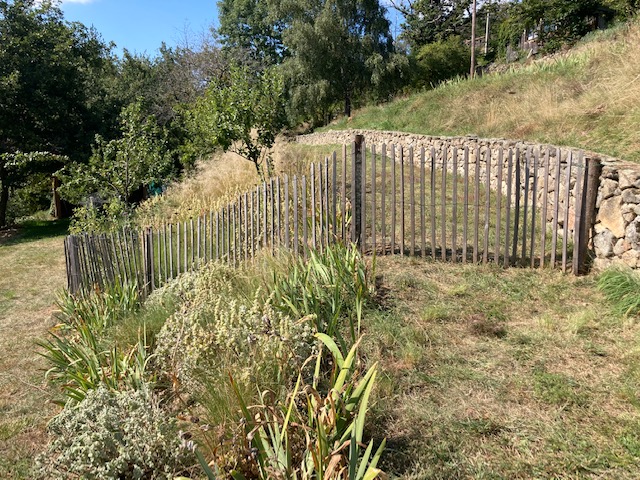
I simply refuse to prize up any more of my lovely fence just to complete the entire orchard. I don’t have the fingers or muscles left. But I yearn for a bit more.
Here’s the picture.
Down came the fence in a roll. I can roll and haul about eight metres of the stuff before my eyes pop and my shoulders really ache.

And then David very kindly wielded mattock and pick to position the fence posts.
Not an easy job in this compacted stone fest of a ground.

Up went the roll. Mind the iris! Oh, too late. Oh well, they will grow again. And sorry about the ballota lacerations. Who knew the old branches of this lovely mediterranean shrub could be so harsh?

Then I had the fun job of piecing together the rest of the fence.

Bits had slid out of their wire supports during the dragging.
It was a rather pleasant morning chore – a kiddies pick-up sticks job and slide them back into the wire.
Then once the lower orchard fence was done, up I went – hauling two separate bits of fence to the duck pond up the track. (Picture those strong man tournaments where the hero has to haul a sea of old car tyres tied together behind him like a raft.)
But curses, my job was uphill.

We had originally positioned the electric fence tape around the first stand of trees near the pool. It’s the original boundary marker between two bits of land. A handsome ash, some elder and oak.
But I am a realist. If I can’t get a free flowing run of mowing an expanse of grass, I just know I will neglect.
And if the fence is here I will leave a wilderness behind the barrier. It is only twenty metres of land wide – the stone terrace delineates one edge, a beautiful pilgrim pathway the far end.

That’s Jean Daniel’s land.
And there is the next stone terrace below to the south. Where the deer live in under the bramble jungle. And where I am often found heaving weeds too pernicious for my compost heap. Egads, what a fess up! But many of us have these hidden areas where bindweed and nasty tap roots go to die.
Here is that patch of land as it used to be.
That leaning tree is the second last white mulberry tree used for the silkworm production way back in the 17th century. (I know, sorry it looks so unremarkable.)
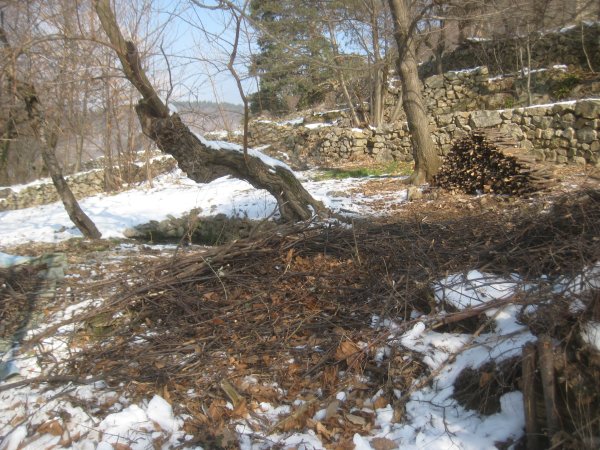
Thank goodness the last white mulberry on the lower terraces (also positioned near a spring) is a mighty beast. Goodness only knows how these two escaped the Phytophthora that wiped out the crop in the 1700s. (It’s possible they were planted much later after the production ended. Anyone who can age trees do step up and oblige.)

And you can help us with the age of this chestnut just below the mulberry.
It has quite the girth. And is even still alive, if not thriving.
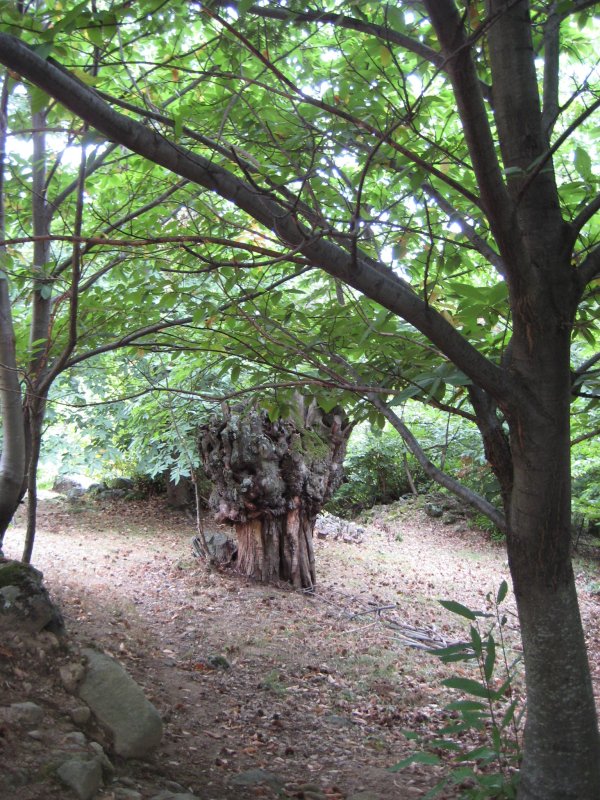
But around that mulberry it was a sorry sight. If I do a quick delve back into the dark days of weed control you can see.
We had a makeshift fence of stacked logs.
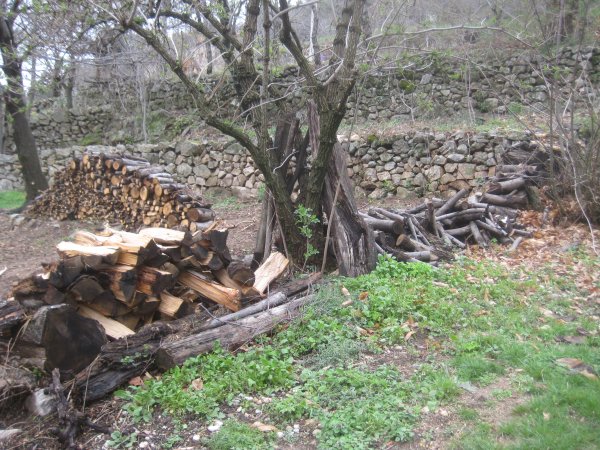
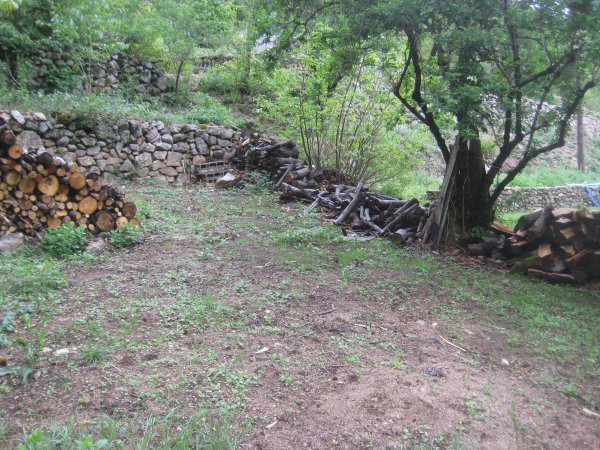
And a marvellous expanse of dirt. Followed swiftly by a thicket of brambles and pioneering weeds in spring.
I worked at this for a few solid years…

And am pretty darn pleased with the result. I don’t fancy it returning to the jungle it once was.
So I paced myself further back into this lush bit of garden where the spring feeds the mulberry and the wild animals and put up another straight line of tape.
Only five more metres into the area. But it might work.
And I can leave a gap at the mulberry so the badgers, hedgehog and deer can nip through. But hopefully not a mad thrashing toddler of a horse.

I have staggered up with the fence. And sort of draped it over the tape.
I need more fence posts. I need more muscles. I need a break from this tedious project.

And you all need to see something a little more interesting and less brown and stick-like.
Next time.
1st September 2021 @ 10:54 am
What a glutton for punishment you are! Fencing in August!
At the end of summer it’s all I can do to stagger around with the watering can occasionally & pick tomatoes & zucchini. All the while hoping for an enormous downpour.
Commiserations on the beastly aoûtats. They haven’t hit here yet … or perhaps that’s just the proof of insufficient time spent in the garden.
1st September 2021 @ 8:21 pm
Believe me, fencing in August was Not On the Agenda. But needs must. I’m so pleased the aoûtats haven’t ventured onto your paths just yet. One does itch like mad.
2nd September 2021 @ 1:10 pm
Never mind the image of strongmen competitions – I see you as a modern-day Sisyphus forever toiling uphill! Loved the photos of the ancient mulberry and the Pilgrim’s path. In the UK I lived in York just behind ‘Mulberry Hall’ and in the garden (yes, lucky me) there was still an ancient mulberry, but a black one. I found that it was probably descended from saplings planted under James Ist – easier to quote than rephrase badly: “Although the mulberry has always been a popular tree, it has never been widely planted only for its fruit. There is one exception, and that was King James I’s attempt to create an English silk industry through the planting of white mulberry trees, whose leaves are the preferred food of the silkworm. This ended in a heroic horticultural failure. The King wrote to the Lord Lieutenants of the English counties in 1607-1608 instructing them to plant mulberry trees. As many as 100,000 were planted, but the King had mistakenly ordered the planting of the black mulberry, upon which the silkworm will not feast. It was an expensive mistake.”
4th September 2021 @ 10:05 am
Ah the mulberry legend. And all I can think of is the incredible stains from the black mulberry on all our clothes. The whites one are definitely more forgiving. But maybe they all succumbed to the dreaded phytophera (typo!) because they were weaker. The black mulberries thrive but the white….
4th September 2021 @ 8:53 pm
Do you think this story is only partly true? It would be a shame, I loved the idea of this blunder on a massive scale. The black mulberry fruit are excellent at sticking to the soles of shoes and transferring their strong dye to beige carpets. Dot, dot, dot from front door to here, there, everywhere… I didn’t know about the fungus infection that decimated white mulberries!
3rd September 2021 @ 3:26 pm
You are an ÜBER trooper, Lindy!!!! And I love the ‘lines’ which you’ve managed to cultivate all round the place, despite frisky ponies & nimble deer …. If only I had half of your tenacity!
3rd September 2021 @ 4:43 pm
Aww thank you!
4th September 2021 @ 10:03 am
you do, you do!
5th September 2021 @ 6:29 am
Ah, Christine, if you are a Pasteur fan you will learn that it was Louis Pasteur who actually worked on the Silkworm problem. Here is an abstract to get you tempted to delver further. From online library.wiley.com. https://onlinelibrary.wiley.com/doi/full/10.1111/j.1469-0691.2012.03945.x
Pasteur became involved in the field of infectious diseases through an epidemic in silkworms in the south of France (1865–1870). In 1853, a mysterious disease, called ‘pébrine’, began to attack the French silkworm nurseries (‘magnaneries’). Silkworm larvae, which normally feed on mulberry leaves, became covered in brown dots, like pepper seeds, and were unable to spin silkworm thread. By 1865, the disease spread to most silkworm-producing areas, and the industry was nearly ruined in France, as in the rest of western Europe. A closely related form of this disease, known as ‘flacherie’ (variants are also known as ‘morts-flats’, ‘gattine’) was also described. Flacherie (or ‘flaccidness’) was characterized by dark brown silkworms. The Academician Jean-Baptiste Dumas asked Pasteur to work on this disease. He went to Alès, a small city in the south of France, in the heart of the silkworm district in the Cevennes. He studied this disease from 1865 to 1870 and established that there were two entirely different diseases, previously considered as variants of the same disease. One was ‘pébrine’ caused by the parasite protozoan (Nosema bombycis), and the other was flacherie, which was believed by Pasteur to be primarily nutritional in origin, with bacterial intestinal proliferation. It is known today that flacherie is the result of a virus with intestinal bacterial superinfection. He proposed an effective prophylaxis based on the selection of non-infected eggs by microscopic examination [1-4]. Then, Pasteur proposed the germ theory to explain all infectious diseases. A Scottish surgeon, Joseph Lister (1827–1912), reading Pasteur’s works, was convinced that suppurated wounds and gangrene were the result of contaminant bacteria. In 1867, he confirmed Pasteur’s conclusions with his own experiments using antiseptics such as phenol to successfully treat wounds.